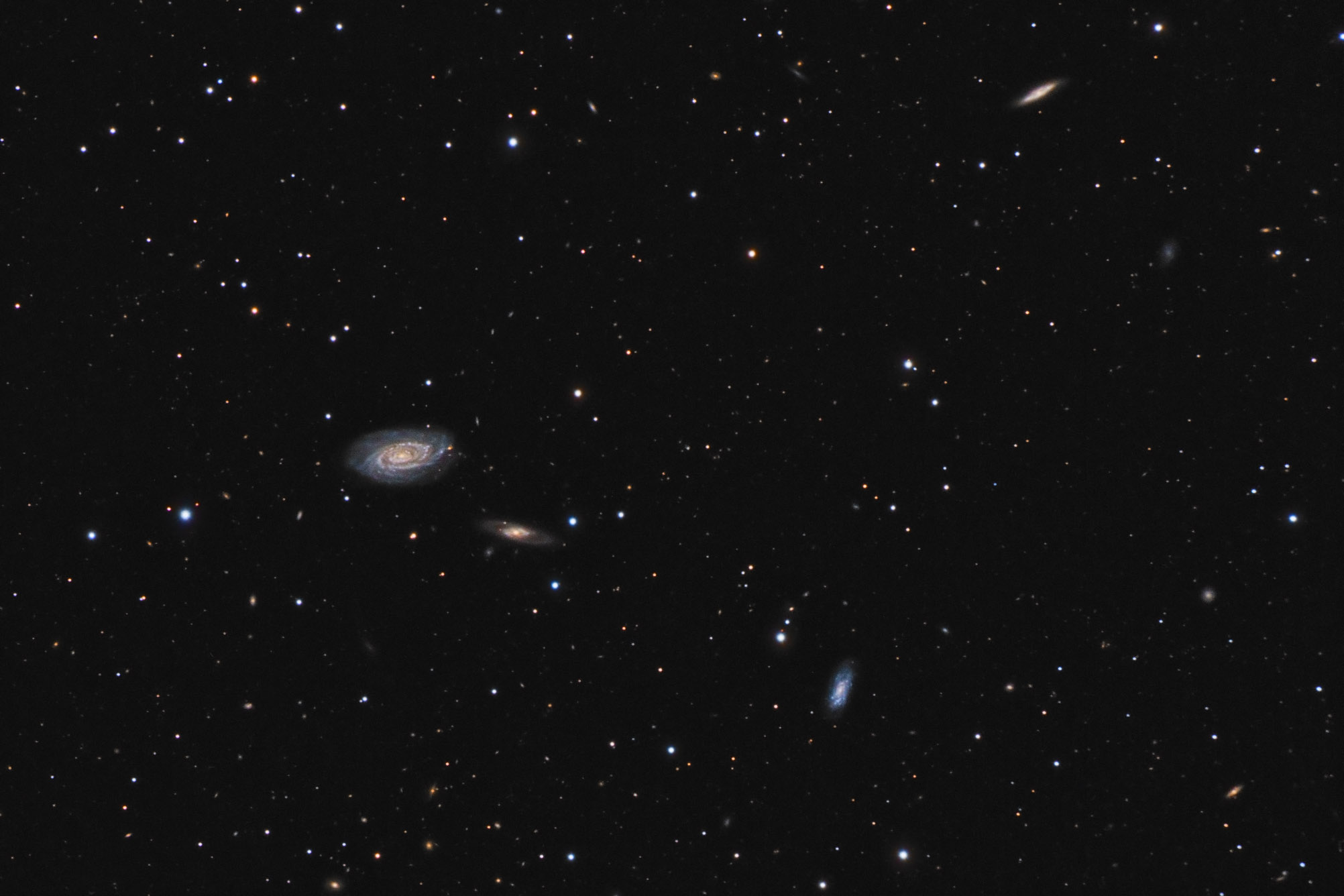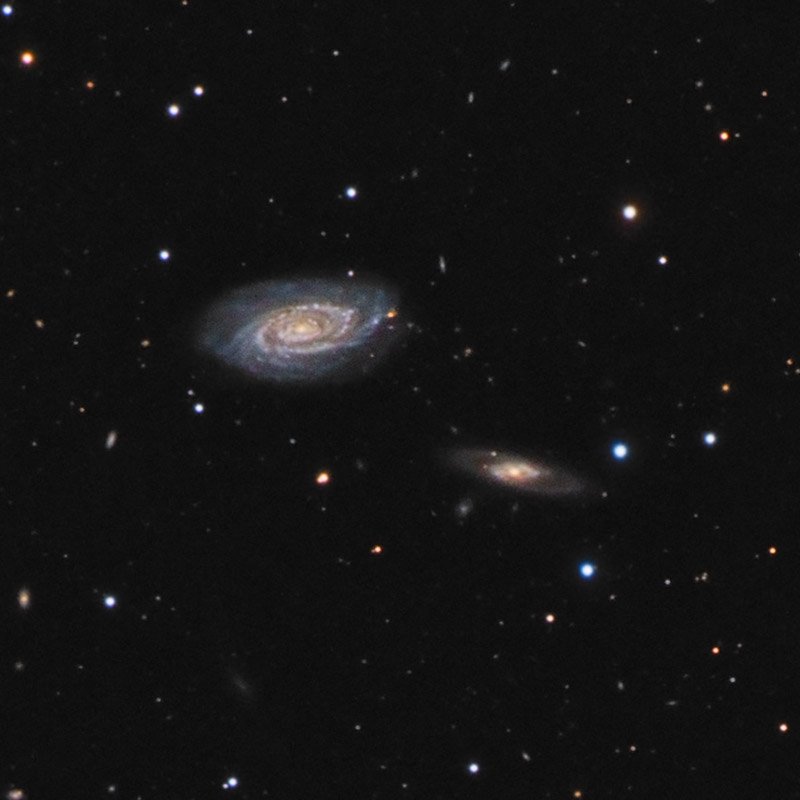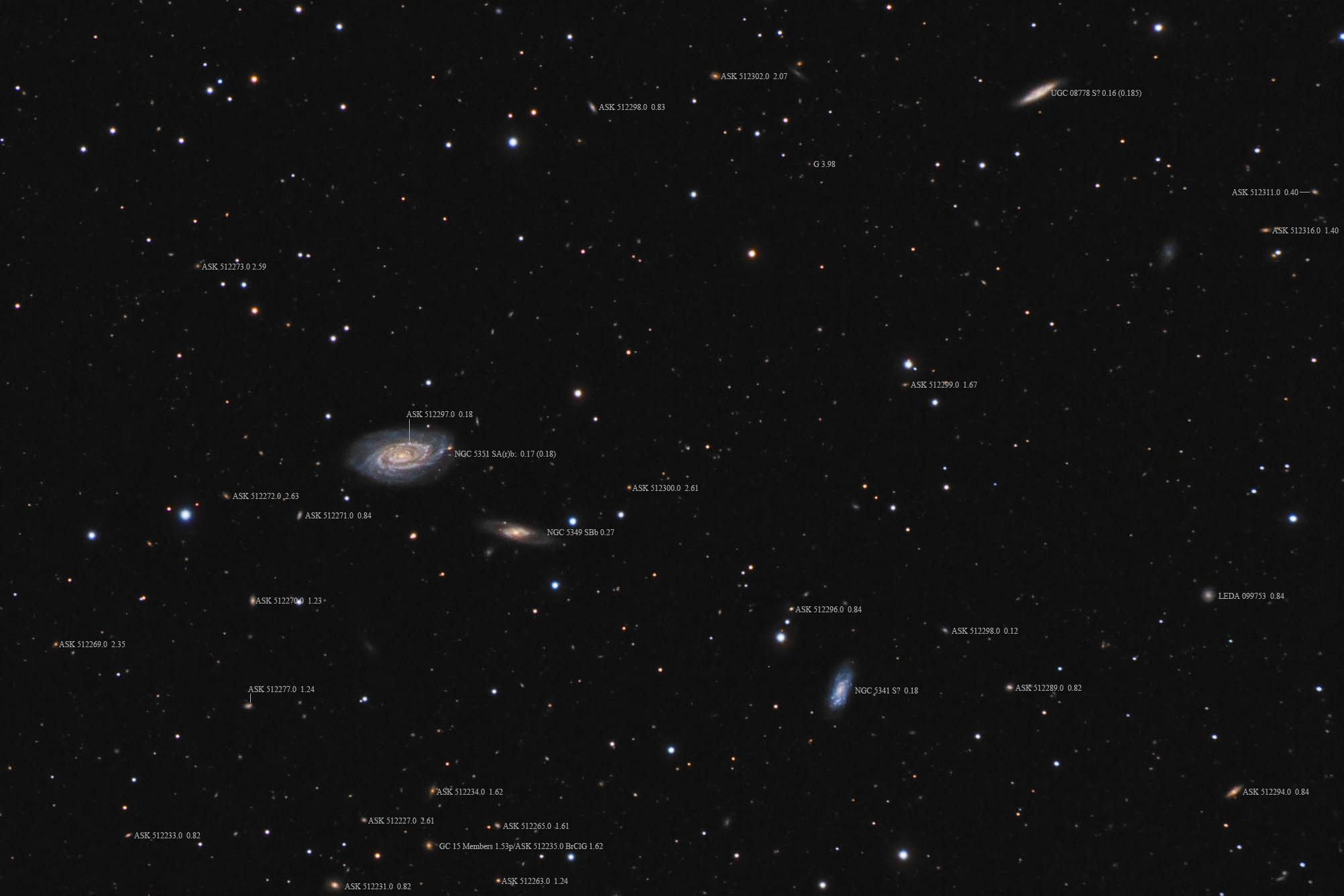Object name: NGC5349Designation(s): NGC5349, NGC5351, NGC4341, UGC08778, Three NGC galaxies and a UGC galaxy plus a lot of background galaxies make for a rather nice field. Two of the NGC galaxies and the UGC galaxy are members of the same group while the fourth lies nearly 100 million light-years further away. The field is found in Canes Venatici.
The "largest" galaxy in the image is NGC 5351 at about 170 to 180 million light-years. It is a nice Sb type spiral with a pseudo-ring and an interesting faint outer region to the north. It was discovered by William Herschel on May 16, 1787 though isn't in either of the Herschel 400 observing lists. NED lists what looks to me like a star cloud in one arm as a separate galaxy. In the Sloan image, it does appear nearly perfectly round while the other blue objects in the arm are elongated. It has a similar redshift. I suppose it is possible it is the remaining core of something NGC 5351 is digesting but I favor it just being a star cloud being so centered in the arm like the other blue knots. It is some 140,000 light-years across so a rather large spiral.
To its southwest is NGC 5349. This one appears smaller but being half again more distant it is really much larger at 183,000 light-years. It is seen rather edge on but its barred structure is obvious. It was discovered by J. J. Mitchell working for the Earl of Rosse. The NGC project credits the Earl with its discovery though it appears he just took credit for his assistants' discoveries.
Further southwest is NGC 5341. This nice spiral lies at about the same redshift and thus likely distance as NGC 5351. It is only about 86,000 light-years across. Still a very respectable size for a spiral. NED lists it as an S? spiral while the NGC project says SBd a rather surprisingly large discrepancy. Like NGC 5349 the NGC project credits its discovery to the Earl of Rosse while it was likely discovered by R. J. Mitchell. He found both on the night of March 24, 1857.
The 4th major member of this image is UGC 8778 to the upper right. A rather featureless mostly red near edge-on spiral. Only a hint of a dust lane is seen in this nearly edge-on spiral. It too is at about 180,000 light-years and 85,000 light-years in diameter so nearly the same size as NGC 5341.
Of the background galaxies, there's a group at a bit over 800 million light-years and another group at a bit over 1.23 billion light-years. The group at a bit over 800 million light-years appears to belong to the Abell 1812 galaxy cluster that is centered a few minutes of arc below the center of my image. It is listed as having up to 49 galaxies so a rather sparse cluster. No size is given for it that I found. I didn't find any group associated with those at 1.23 billion light-years.
In all the years (over 9) I've used the Paramount I've never had to throw out a frame due to a tracking issue until this image. One red frame showed a faint second image of brighter stars about 3 seconds of arc to the southeast. Since this was not guided and I wasn't around (well I was but sleeping) I don't know what happened. I guess one out of over 15,000 frames isn't a bad percentage but I'd like to know what happened. I see no trail between the two images though for those bright enough to have trailed in a fast move it would be lost in the glare. It appears about 1% of the light is in this second image, just enough to show up in the bright stars. I threw out the frame as the single good red frame still gave me good color.
14" LX200R @ f/10, L=4x10' R=1x10' GB=2x10', STL-11000XM, Paramount ME Related Designation(s):2MASS J13520667+3804013, 2MASS J13531314+3752592, 2MASS J13532772+3754540, 2MASX J12235347+0706261, 2MASX J13520665+3804010, 2MASX J13531316+3752592, 2MASX J13532769+3754542, 2MASXi J1352066+380401, 2MASXi J1353131+375258, 2MASXi J1353276+375452, 2MASXi J1353277+375452, 2MFGC 11195, AKARI J1353125+375256, AKARI J1353271+375457, ASK 390371.0, ASK 512301.0, CALIFA 664, CGCG 042-076, CGCG 1221.4+0723, CGCG 1349.9+3819, CGCG 1351.0+3808, CGCG 1351.3+3810, CGCG 190-068, CGCG 190-072, CGCG 190-073, CGCG 191-001, CGCG 191-006, CGCG 191-008, ECO 04336, ECO 04348, ECO 04351, EVCC 0496, FIRST J135313.1+375259, GALEXASC J135206.76+380400.2 , GALEXMSC J135206.71+380400.6 , HDCE 0720 NED061, HOLM 554A, HOLM 554B, IC 3260, IRAS 13510+3807, IRAS 13513+3809, IRAS F13510+3807, IRAS F13513+3809, ISOSS 061, ISOSS J13533+3755, KUG 1351+381, LDCE 0904 NED083, LDCE 1018 NED003, LDCE 1021 NED001, LDCE 1021 NED002, LGG 292:[G93] 072, LGG 364:[G93] 001, LGG 366:[G93] 002, MAPS-NGP O_556_0154674, MCG +01-32-042, MCG +06-31-001, MCG +06-31-005, MCG +06-31-008, NGC 4341, NGC 5349, NGC 5351, NGC4341, NGC5349, NGC5351, NSA 067257, NSA 089323, NSA 144017, NSA 144029, NVSS J135313+375259, NVSS J135327+375459, PGC 040280, PGC 049237, PGC 049336, PGC 049359, SDSS J122353.55+070625.6, SDSS J122353.56+070625.6, SDSS J135206.66+380401.2, SDSS J135206.67+380401.2, SDSS J135206.67+380401.3, SDSS J135313.12+375259.3, SDSS J135327.71+375453.9, UGC 07472, UGC 08778, UGC 08803, UGC 08809, UGC08778, USGC U490 NED280, USGC U575 NED01, USGC U575 NED04, UZC J122353.5+070625, UZC J135206.7+380401, UZC J135313.1+375259, UZC J135327.7+375452, VCC 0672, WBL 403-004, [M98j] 210 NED02, [MGD2014] 1351.0+3807, [SLK2004] 0921, [TTL2012] 523749, | | 

